Shaft Wall Damage to High-Depth Inclined Ore Passes under Impact Wear Behavior
Abstract
:1. Introduction
2. Shaft Wall Damage Model for High-Depth Inclined Ore Passes
2.1. Basic Model
2.2. Basic Assumptions
- (1)
- The extracted ore is assumed to be a sphere of uniform mass, and the moving ore is regarded as a particle. Only the translation of the ore is considered, while the rotation of the ore is neglected.
- (2)
- The shaft is a flat and inclined cylinder with the same lithology throughout, and the rock mass of the shaft wall obeys the Mohr–Coulomb criterion.
- (3)
- Only the interaction between the ore and the shaft wall is considered, while the interaction between ores and the mass loss of ores are neglected.
2.3. Theoretical Solution
2.3.1. Ore Indentation Depth δ
- (1)
- Elastic deformation stage
- (2)
- Plastic deformation stage
2.3.2. Wear Length l
2.3.3. Shaft Wall Damage Volume Q
3. Engineering Case
3.1. Rationality of the Shaft Wall Damage Model for High-Depth Inclined Ore Passes
3.1.1. Engineering Survey
3.1.2. Parameter Selection
3.1.3. Result Analysis
3.2. Influence of Ore-Pass Depth H
3.3. Influence of Ore-Pass Dip Angle θ
3.4. Influence of Inclined Angle of the Chute α
3.5. Influence of Shaft Diameter D
3.6. Influence of Ore Block Size P
3.7. Sensitivity Analysis of Influencing Factors
4. Discussion
5. Conclusions
Author Contributions
Funding
Institutional Review Board Statement
Informed Consent Statement
Data Availability Statement
Acknowledgments
Conflicts of Interest
References
- Jiang, L.C.; Jiao, H.Z.; Wang, Y.D.; Wang, G.G. Comprehensive safety factor of roof in goaf underdeep high stress. J. Cent. South Univ. 2021, 28, 595–603. [Google Scholar] [CrossRef]
- Li, X.B.; Li, D.Y.; Guo, L.; Ye, Z.Y. Study on mechanical response of highly-stressed pillars in deep mining under dynamic disturbance. Chin. J. Rock Mech. Eng. 2007, 5, 922–928. Available online: http://www.cqvip.com/qk/96026x/20075/25633817.html (accessed on 21 November 2023).
- Jiang, L.C.; Zhang, Y.Q. Calculation model of depressurization coefficient for concrete helical pipeline transportation in deep shaft. J. Xi’an Univ. Sci. Technol. 2020, 40, 953–959. [Google Scholar] [CrossRef]
- Guo, F.; Zhang, N.; Xie, Z.Z.; Han, C.L.; Zhang, C.H.; Yuan, Y.X.; He, Z.; Liu, J.H. A Three-Dimensional Supporting Technology, Optimization and Inspiration from a Deep Coal Mine in China. Rock Mech. Rock Eng. 2023, 2023, 1–23. [Google Scholar] [CrossRef]
- Xie, J.L.; Ning, S.; Zhu, W.B.; Wang, X.Z.; Hou, T. Influence of Key Strata on the Evolution Law of Mining-Induced Stress in the Working Face under Deep and Large-Scale Mining. Minerals 2023, 13, 983. [Google Scholar] [CrossRef]
- Li, X.B.; Yao, J.R.; Gong, F.Q. Dynamic problems in deep exploitation of hard rock metal mines. Chin. J. Nonferrous Met. 2011, 21, 2551–2563. [Google Scholar] [CrossRef]
- Lu, Z.X.; Ma, C.; Cao, P.; Ma, Q.Y. Study Status and Direction of Orepass Existing Problems in Metal Mine. Met. Mine 2019, 2019, 1–9. [Google Scholar] [CrossRef]
- Zhao, Y.; Ye, H.W.; Lei, T.; Wang, C.; Wang, Q.Z.; Long, M. Theoretical study of damage characteristics on ore pass wall based on the erosion-wearing theory. Chin. J. Rock Mech. Eng. 2017, 36, 4002–4007. [Google Scholar] [CrossRef]
- Yin, Y.; Lu, Z.X.; Ma, C. Mechanism of Deformation and Failure on Orepass Wall under Impact and Wear. Met. Mine 2020, 2020, 31–36. [Google Scholar] [CrossRef]
- Yin, Y.; Lu, Z.X.; Dong, H.W. Analysis and Verification of 3D Motion Track of Ore or Rock in Main Orepass. Met. Mine 2019, 2019, 49–53. [Google Scholar] [CrossRef]
- Deng, Z.; Lu, Z.X.; Wang, S.Y.; Ma, Q.Y. Influence and mechanism of upper unloading impact on the pressure distribution of the sidewall in the storage section of the orepass. Nonferrous Met. Sci. Eng. 2023, 14, 257–263. [Google Scholar] [CrossRef]
- Liu, Y.Z.; Zhang, B.T.; Ye, Y.C.; Zou, X.T.; Zhang, Q.; Chen, X.Q.; Pan, S.H. Similarity testing study on characteristics of ore motion and wall damage in mine shaft. J. Min. Saf. Eng. 2018, 35, 545–552. [Google Scholar] [CrossRef]
- Liu, Y.Z.; Wang, Q.F.; Ye, Y.C.; Zhao, W.; Shi, Z.J.; Tu, F.Q. Ore-pass panoramic scanning imaging device and its experiment to monitor ore-pass wall. Rock Soil Mech. 2013, 34, 3329–3334. [Google Scholar] [CrossRef]
- Ren, Z.G.; Ma, H.T.; Wang, S.; Zeng, M.R.; Jin, L.Z. Experimental study on damage laws of ore pass based on similarity simulation. J. Saf. Sci. Technol. 2016, 12, 98–102. [Google Scholar] [CrossRef]
- Esmaieli, K.; Hadjigeorgiou, J.; Grenon, M. Stability Analysis of the 19A Ore Pass at Brunswick Mine Using a Two-Stage Numerical Modeling Approach. Rock Mech. Rock Eng. 2013, 46, 1323–1338. [Google Scholar] [CrossRef]
- Esmaieli, K.; Hadjigeorgiou, J. Selecting ore pass-finger raise configurations in underground mines. Rock Mech. Rock Eng. 2011, 44, 291–303. [Google Scholar] [CrossRef]
- Campbell, C.S. Granular material flows–an overview. Powder Technol. 2006, 162, 208–229. [Google Scholar] [CrossRef]
- Kulshrestha, A.; Chang, L.; Stein, A. Sinkhole scanner: A new method to detect sinkhole-related spatio-temporal patterns in InSAR deformation time series. Remote Sens. 2021, 13, 2906. [Google Scholar] [CrossRef]
- Remennikov, A.M.; Mutton, V.; Nimbalkar, S. Experimental and numerical investigation of high-yield grout ore pass plugs to resist impact loads. Int. J. Rock Mech. Min. Sci. 2014, 70, 1–15. [Google Scholar] [CrossRef]
- Ma, J.Y.; Wei, D.E.; Zhang, Q.S. Experimental study on the probabilities of kinked arches and kinked arch locations in ore passes under the influences of multiple factors. Sci. Rep. 2023, 13, 15364. [Google Scholar] [CrossRef]
- Vo, T.; Yang, H.; Russell, A.R. Cohesion and suction induced hang-up in ore passes. Int. J. Rock Mech. Min. Sci. 2016, 87, 113–128. [Google Scholar] [CrossRef]
- Yang, Y.J.; Deng, Z.; Lu, Z.X. Effects of ore-rock falling velocity on the stored materials and the force on the shaft wall in a vertical orepass. Mech. Adv. Mater. Struct. 2022, 30, 3455–3462. [Google Scholar] [CrossRef]
- Xiong, Y.; Yang, S.L.; Kong, D.Z.; Song, G.F.; Ma, Z.Q.; Zuo, Y.J. Analysis on early warning of coal sample failure based on crack development law and strain evolution characteristics. Eng. Fail. Anal. 2023, 148, 107170. [Google Scholar] [CrossRef]
- Hadjigeorgiou, J.; Lessard, J.F. Numerical investigations of ore pass hang-up phenomena. Int. J. Rock Mech. Min. Sci. 2007, 44, 820–834. [Google Scholar] [CrossRef]
- Hou, T.X.; Yang, X.G.; Huang, C.; Huang, K.X.; Zhou, J.W. A calculation method based on impulse theorem to determine impact force of rockfall on structure. Chin. J. Rock Mech. Eng. 2015, 34, 3116–3122. [Google Scholar] [CrossRef]
- Braccesi, C.; Landi, L. A general elastic–plastic approach to impact analisys for stress state limit evaluation in ball screw bearings return system. Int. J. Impact Eng. 2007, 34, 1272–1285. [Google Scholar] [CrossRef]
- Jackson, R.L.; Green, I.; Marghitu, D.B. Predicting the coefficient of restitution of impacting elastic-perfectly plastic spheres. Nonlinear Dyn. 2010, 60, 217–229. [Google Scholar] [CrossRef]
- Green, I. The prediction of the coefficient of restitution between impacting spheres and finite thickness plates undergoing elastoplastic deformations and wave propagation. Nonlinear Dyn. 2022, 109, 2443–2458. [Google Scholar] [CrossRef]
- Zhang, G.C.; Tang, H.M.; Xiang, X.; Karakus, M.; Wu, J.P. Theoretical study of rockfall impacts based on logistic curves. Int. J. Rock Mech. Min. Sci. 2015, 78, 133–143. [Google Scholar] [CrossRef]
- Thornton, C. Coefficient of Restitution for Collinear Collisions of Elastic-Perfectly Plastic Spheres. J. Appl. Mech. 1997, 64, 383. [Google Scholar] [CrossRef]
- Benabdallah, S.M.H.; Chalifoux, J.P. Ploughing of soft asperities by a hemispherical slider. Tribol. Int. 1989, 22, 383–388. [Google Scholar] [CrossRef]
- Cui, G.S.; Bao, Z.W.; Li, Q. The origin of hydrothermal dolomite in the Huize giant Pb-Zn ore-field in the Yunnan province and its geological implications. Geotecton. et Metallog. 2023, 47, 361–375. [Google Scholar] [CrossRef]
- Zhang, Y.; Han, R.S.; Hu, T.C.; Wei, P.T.; Wang, L. The tectonics-fluids-mineralization coupling processes in the Huize ultra-large Ge-rich Pb-Zn deposit. Geotecton. et Metallog. 2023, 47, 969–983. [Google Scholar] [CrossRef]
- Vergara, M.R.; Arismendy, A.; Libreros, A.; Brzovic, A. Numerical investigation into strength and deformability of veined rock mass. Int. J. Rock Mech. Min. Sci. 2020, 135, 104510. [Google Scholar] [CrossRef]
- Yang, J.P.; Chen, W.Z.; Yang, D.S.; Yuan, J.Q. Numerical determination of strength and deformability of fractured rock mass by FEM modeling. Comput. Geotech. 2015, 4, 20–31. [Google Scholar] [CrossRef]
- Giner, E.; Sukumar, N.; Tarancón, J.E.; Fuenmayor, F.J. An Abaqus implementation of the extended finite element method. Eng. Fract. Mech. 2009, 76, 347–368. [Google Scholar] [CrossRef]
- Naik, D.L.; Kiran, R. A novel sensitivity-based method for feature selection. J. Big Data 2021, 8, 128. [Google Scholar] [CrossRef]
- Asheghi, R.; Hosseini, S.A.; Saneie, M.; Shahri, A.A. Updating the neural network sediment load models using different sensitivity analysis methods: A regional application. J. Hydroinformatics 2020, 22, 562–577. [Google Scholar] [CrossRef]
- Ngaradoumbe Nanhorngué, R.; Pesavento, F.; Schrefler, B.A. Sensitivity analysis applied to finite element method model for coupled multiphase system. Int. J. Numer. Anal. Methods Geomech. 2013, 37, 2205–2222. [Google Scholar] [CrossRef]
- Yang, Q.; Peng, X. Sensitivity analysis using a reduced finite element model for structural damage identification. Materials 2021, 14, 5514. [Google Scholar] [CrossRef]
- Li, H.; Zha, J.; Guo, G. A new dynamic prediction method for surface subsidence based on numerical model parameter sensitivity. J. Clean. Prod. 2019, 233, 1418–1424. [Google Scholar] [CrossRef]
- Song, W.D.; Wang, Y.H.; Wang, X.; Du, J.H. Theoretical analysis and test of impact load due to ore dumping in chute. Rock Soil Mech. 2011, 32, 326–332. [Google Scholar] [CrossRef]
- Mei, X.F.; Hu, X.W.; Luo, G.; Du, Y.J.; Ma, H.S.; Wu, J.L. A study on the coefficient of restitution and peak impact of rockfall based on the elastic-plastic theory. J. Vib. Shock 2019, 38, 14–20. [Google Scholar] [CrossRef]
- Chen, T.J.; Xiang, X.; Zhang, G.C. Characteristic parameters theoretical analysis of rockfall impact on ground based on linear viscoelastic contact theory. Rock Soil Mech. 2022, 43, 2410–2420. [Google Scholar] [CrossRef]
- Chen, Q.F.; Liu, E.J.; Qin, S.K. Quantitative study on evolution characteristics of force chain of granular materials in ore drawing from multiple funnels process. J. Cent. South Univ. (Sci. Technol.) 2021, 52, 4046–4054. [Google Scholar] [CrossRef]
- Schormair, N.; Thuro, K.; Plinninger, R. The Influence of Anisotropy on Hard Rock Drilling and Cutting; The Geological Society of London: London, UK; IAEG: San Francisco, CA, USA, 2006; Volume 491, pp. 1–11. Available online: http://www.plinninger.eu/images/pdfs/2006_iaeg_anisotropy.pdf (accessed on 20 November 2023).
- Bołoz, Ł. Interpretation of the results of mechanical rock properties testing with respect to mining methods. Acta Montan. Slovaca 2020, 25, 1. Available online: https://actamont.tuke.sk/pdf/2020/n1/8boloz.pdf (accessed on 20 November 2023).
- Małkowski, P. The impact of the physical model selection and rock mass stratification on the results of numerical calculations of the state of rock mass deformation around the roadways. Tunn. Undergr. Space Technol. 2015, 50, 365–375. [Google Scholar] [CrossRef]
- Bachmann, H.; Linde, P.; Wenk, T. Capacity design and nonlinear dynamic analysis of earthquake-resistant structures. IBK Sonderdr. 1994, 1994, 2. [Google Scholar] [CrossRef]
- Qu, B.; Bruneau, M. Capacity design of intermediate horizontal boundary elements of steel plate shear walls. J. Struct. Eng. 2010, 136, 665–675. [Google Scholar] [CrossRef]
- Broberg, M.; Shafaei, S.; Kizilarslan, E.; Seo, J.; Varma, A.H.; Bruneau, M.; Klemencic, R. Capacity design of coupled composite plate shear wall–concrete-filled system. J. Struct. Eng. 2022, 148, 04022022. [Google Scholar] [CrossRef]
- Barbato, M.; Conte, J.P. Finite element response sensitivity analysis: A comparison between force-based and displacement-based frame element models. Comput. Methods Appl. Mech. Eng. 2005, 194, 1479–1512. [Google Scholar] [CrossRef]
- Hansson, S.; Jansson, T. Sensitivity analysis of a finite element model for the simulation of stainless steel tube extrusion. J. Mater. Process. Technol. 2010, 210, 1386–1396. [Google Scholar] [CrossRef]
- Rooks, N.B.; Besier, T.F.; Schneider, M.T.Y. A Parameter Sensitivity Analysis on Multiple Finite Element Knee Joint Models. Front. Bioeng. Biotechnol. 2022, 10, 841882. [Google Scholar] [CrossRef] [PubMed]
- Swendsen, R.H.; Wang, J.S. Nonuniversal critical dynamics in Monte Carlo simulations. Phys. Rev. Lett. 1987, 58, 86. [Google Scholar] [CrossRef] [PubMed]
- Theodorou, D.N. Progress and outlook in Monte Carlo simulations. Ind. Eng. Chem. Res. 2010, 49, 3047–3058. [Google Scholar] [CrossRef]
- Xu, J.L. Reducing FEM Solution Errors with Quad Precision Arithmetic. Struct. Anal. 2022, 2022, 12–16. Available online: https://www.structuremag.org/?p=22193 (accessed on 27 November 2023).
- Jakobsson, H.; Larson, M.G.; Granåsen, G. Reduction of finite element models of complex mechanical components. SIMS 2007, 2007, 88. Available online: https://ep.liu.se/ecp/027/010/ecp072710.pdf (accessed on 28 November 2023).
- Dogančić, B.; Jokić, M. Discretization and Model Reduction Error Estimation of Interconnected Dynamical Systems. IFAC-Pap. 2022, 55, 177–182. Available online: https://creativecommons.org/licenses/by-nc-nd/4.0/ (accessed on 28 November 2023). [CrossRef]
- Halilović, D.; Gligorić, M.; Gligorić, Z.; Pamučar, D. An Underground Mine Ore Pass System Optimization via Fuzzy 0–1 Linear Programming with Novel Torricelli–Simpson Ranking Function. Mathematics 2023, 11, 2914. [Google Scholar] [CrossRef]
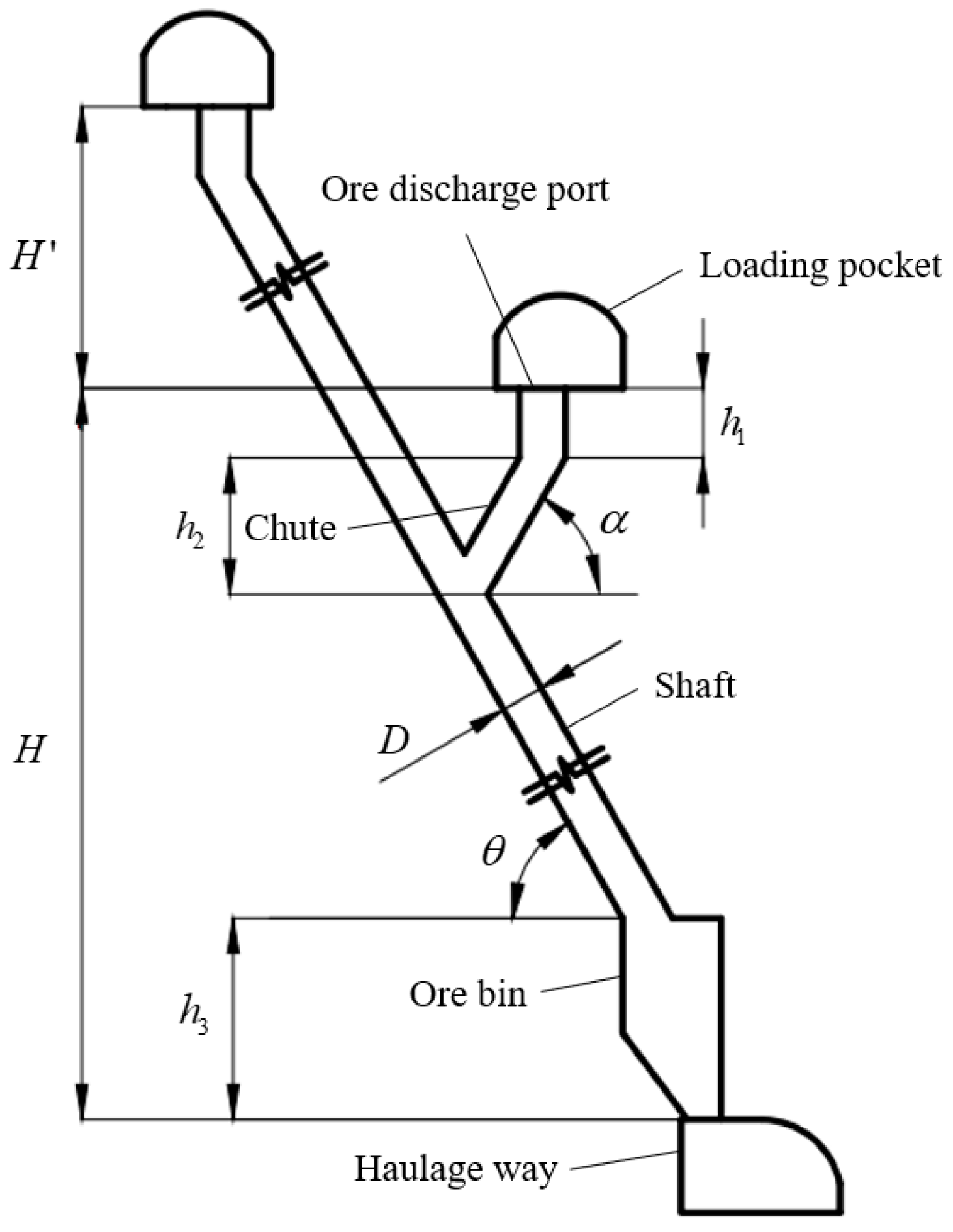
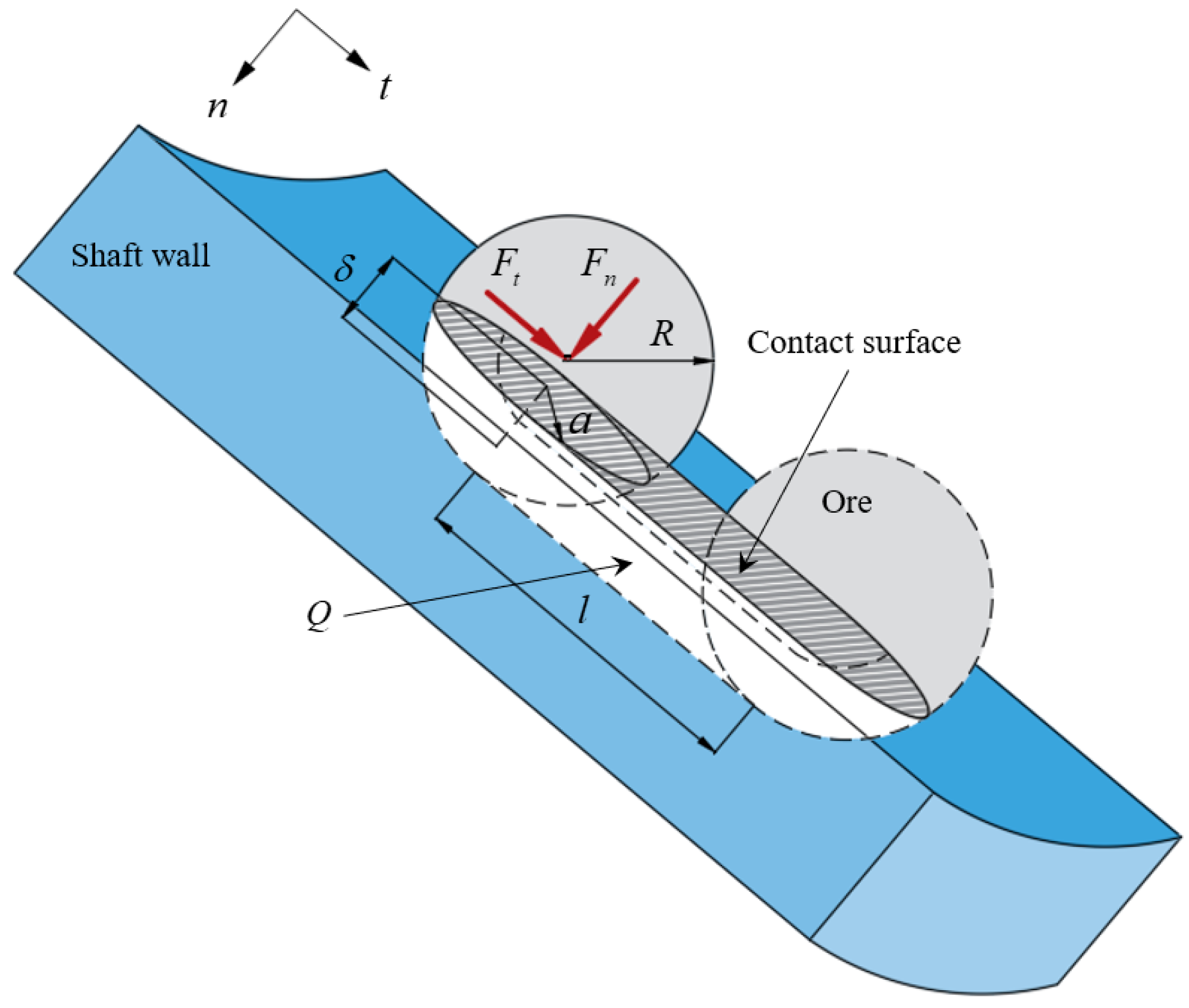
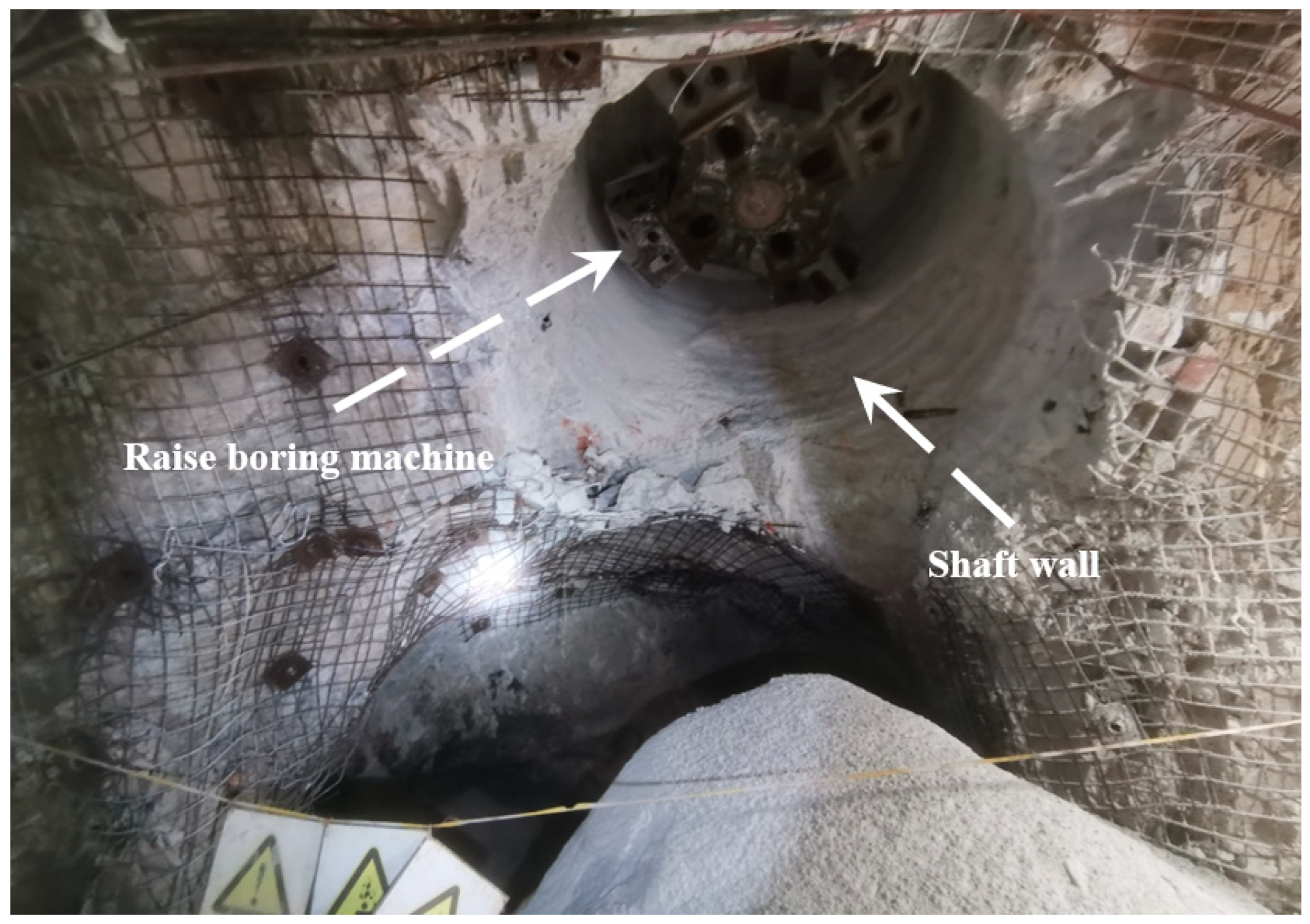
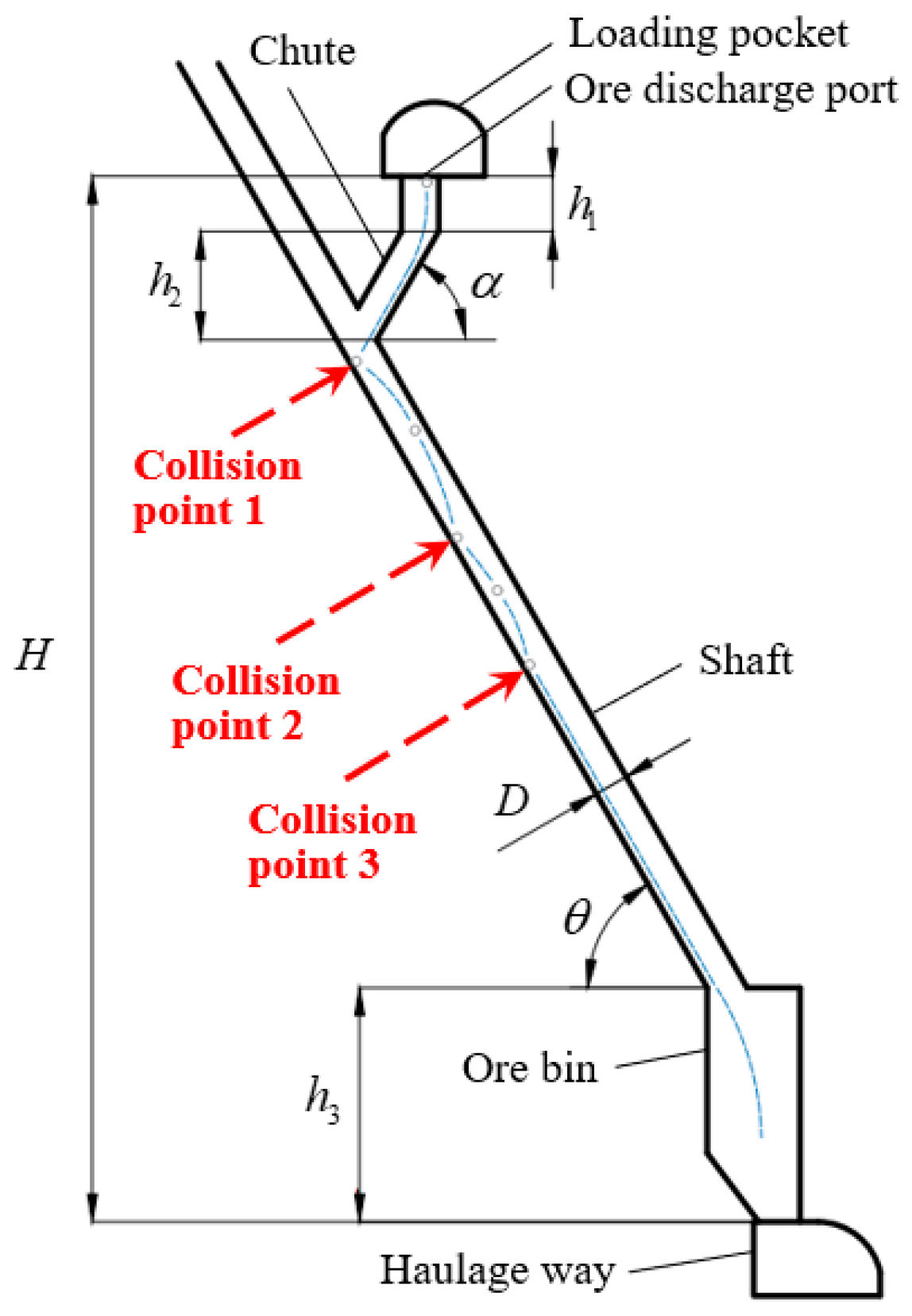
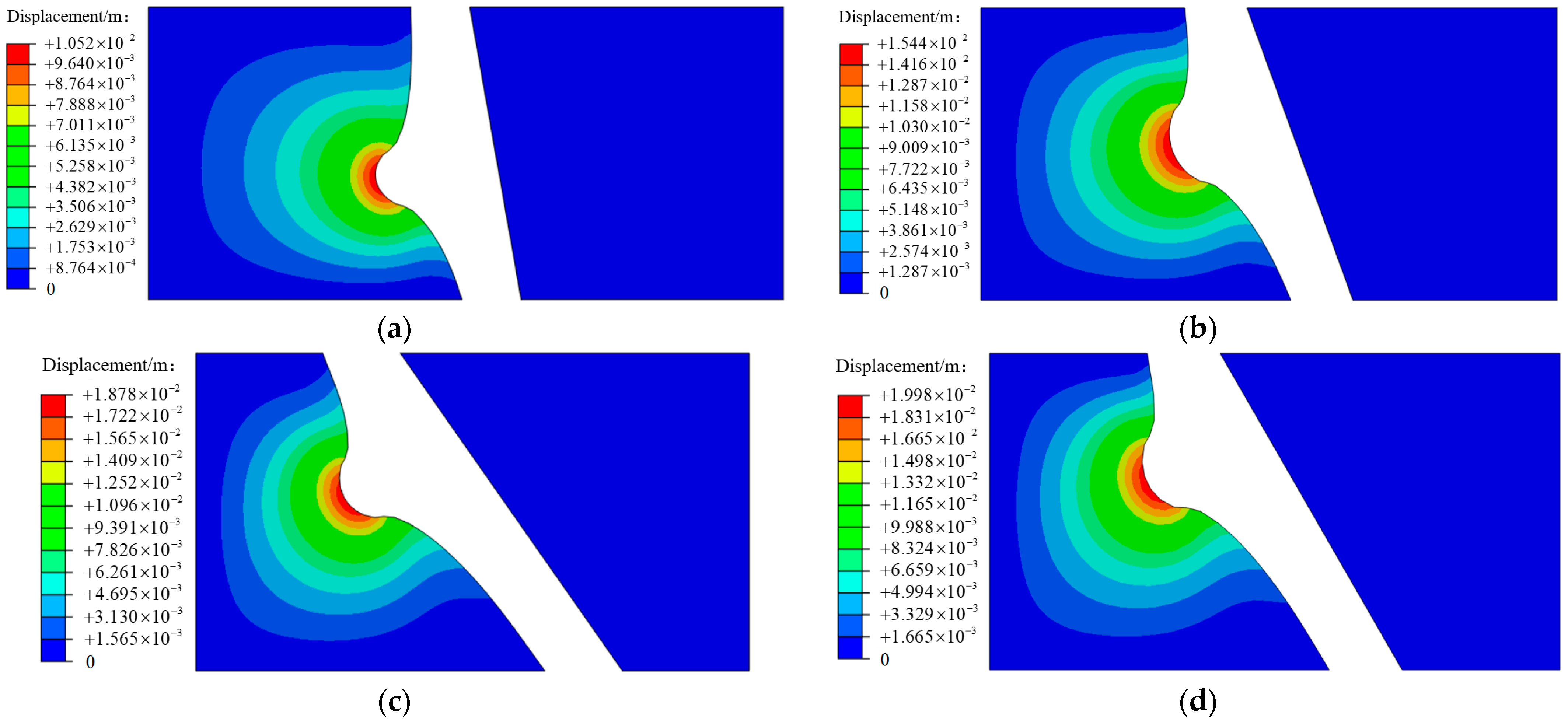
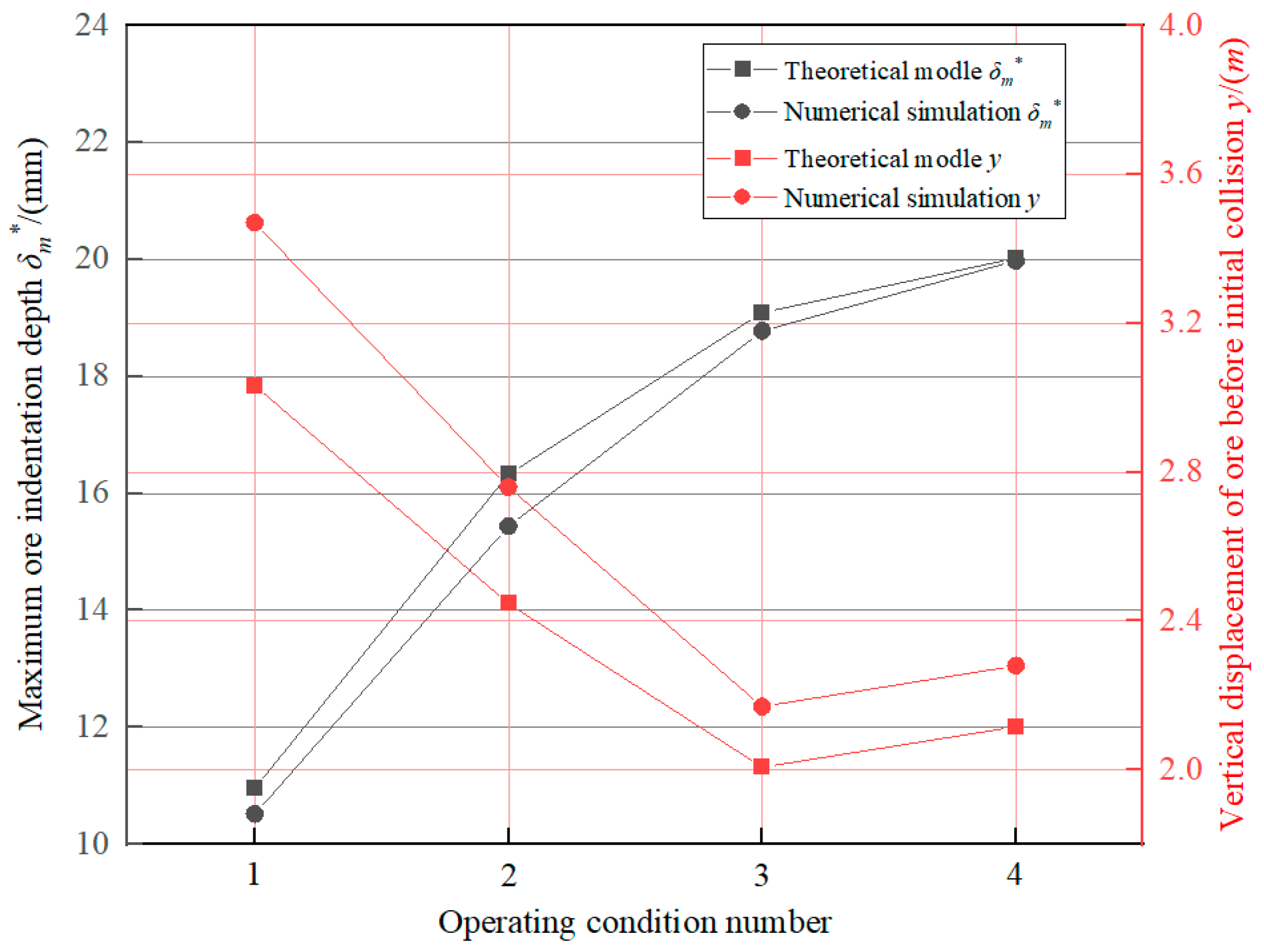
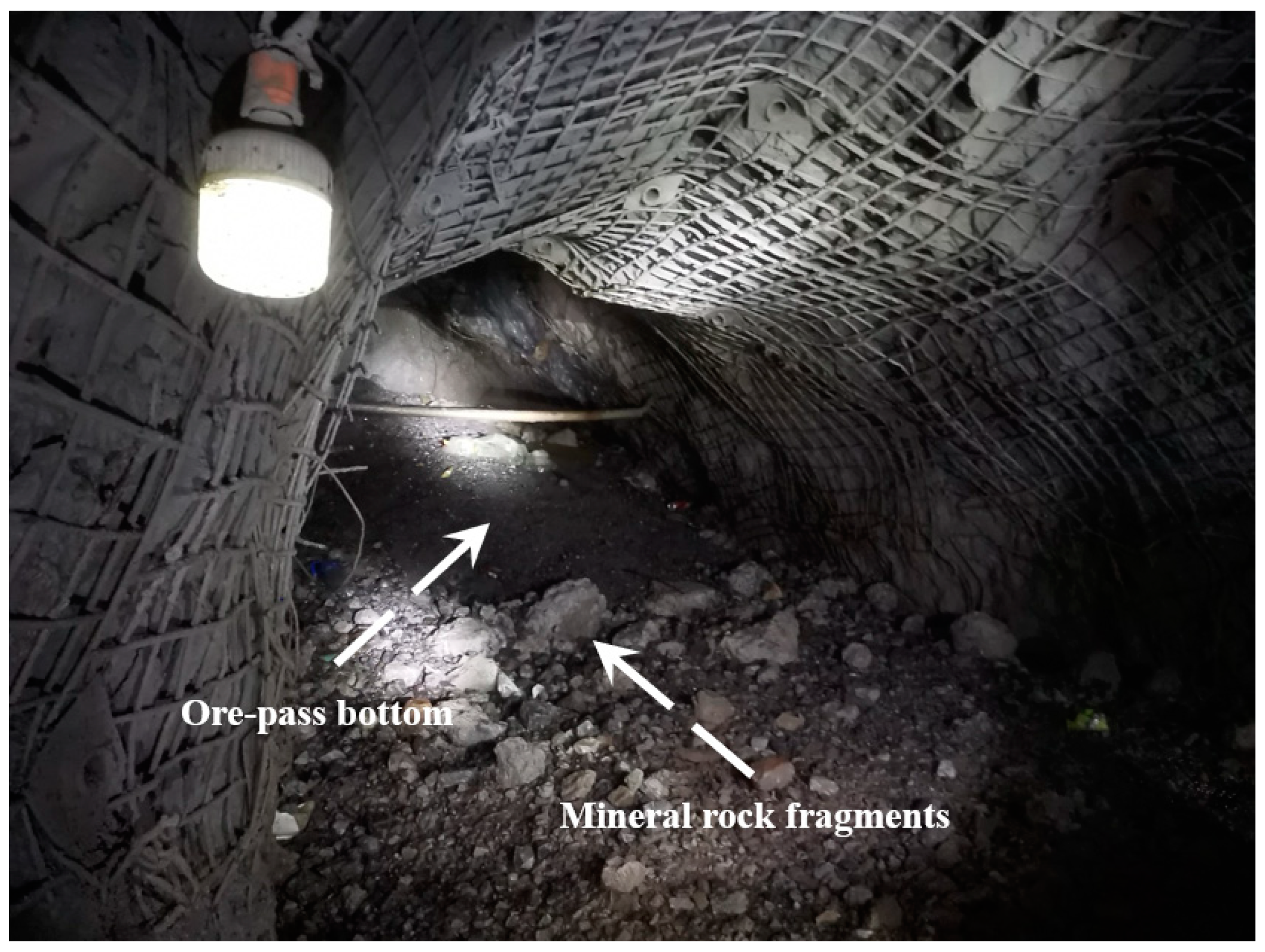

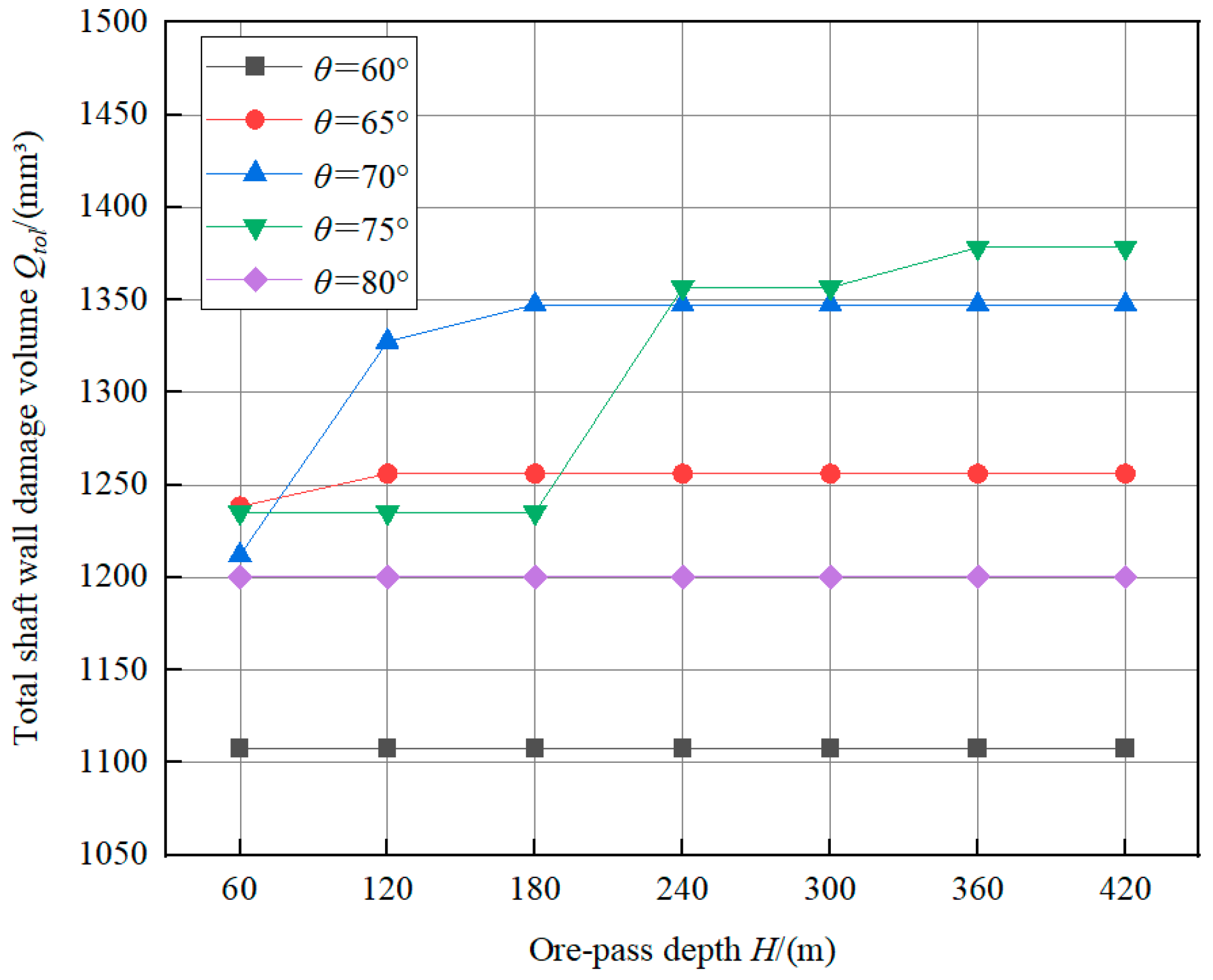

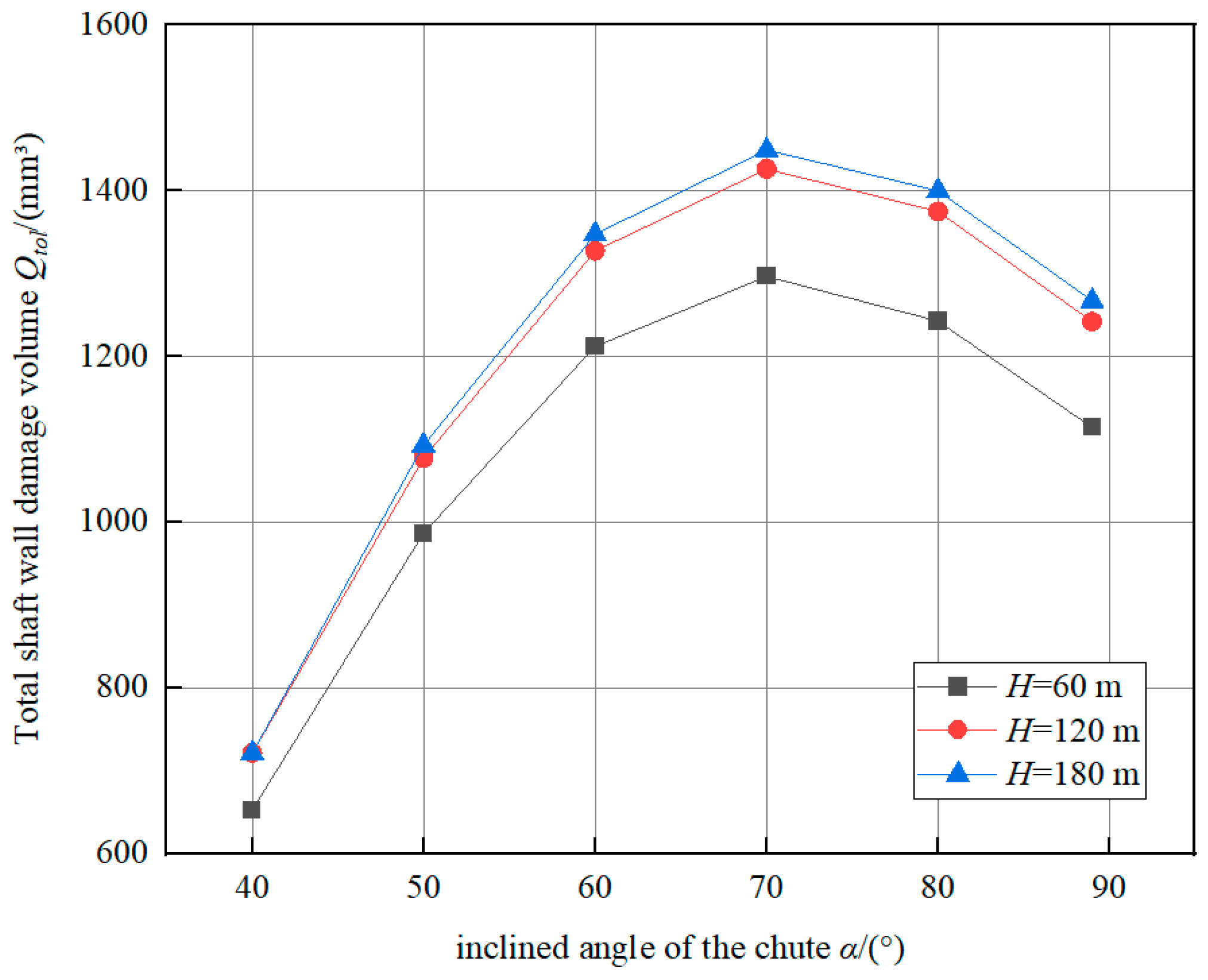


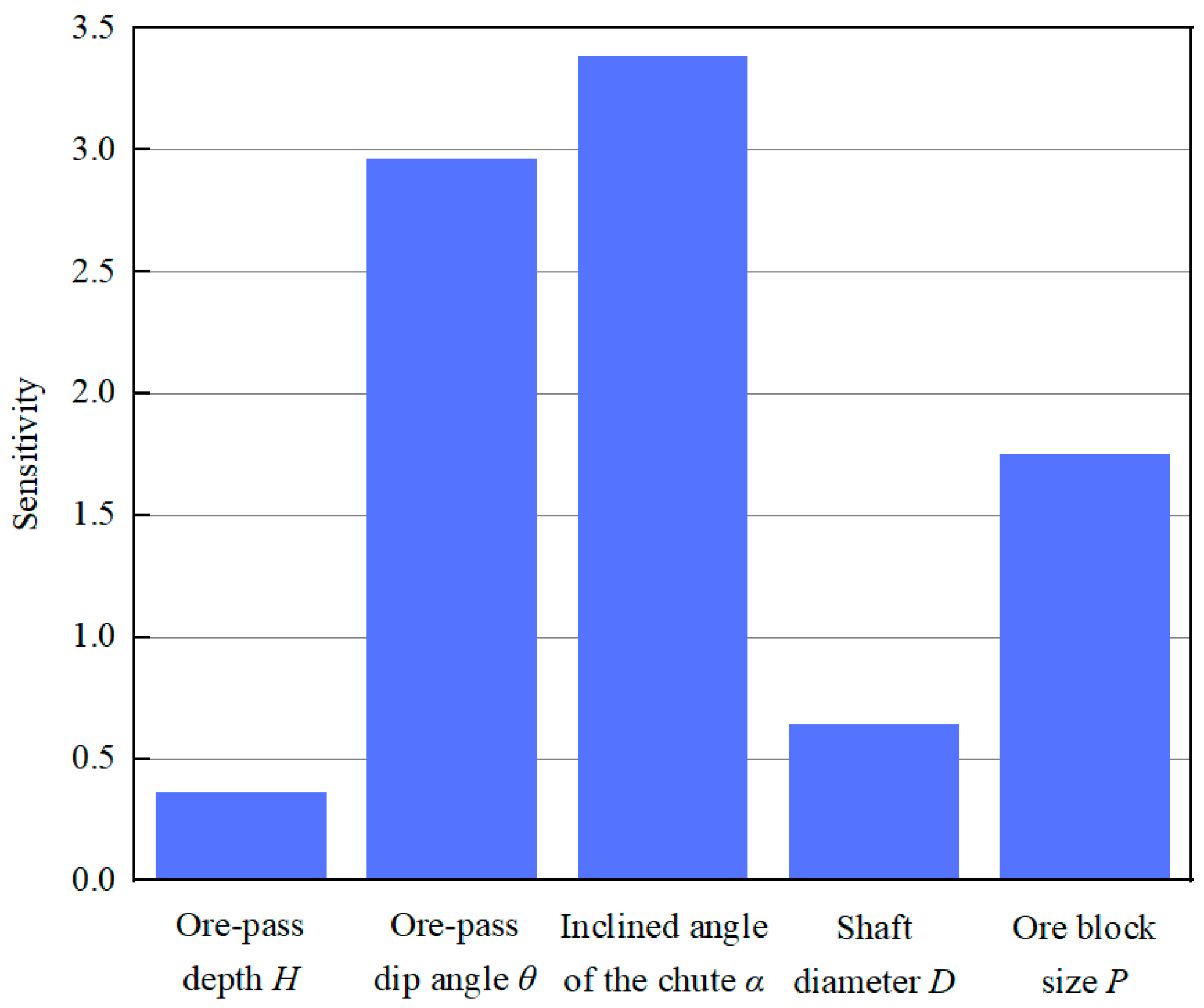
| Type | Elastic Modulus E/(GPa) | Poisson Ratio ν/(-) | Volumetric Weight γ/(KN·m−3) | Initial Yield Strength σq/(MPa) | Friction Angle /(°) | Cohesion c/(MPa) | Coefficient of Sliding Friction /(-) |
|---|---|---|---|---|---|---|---|
| Shaft wall rock mass | 16.80 | 0.26 | 27.80 | 59.52 | 42 | 10.60 | 0.40 |
| Ore | 14.09 | 0.25 | 40.80 | — | — | — |
| Operating Condition | Ore-Pass Dip Angle /(°) | Shaft Diameter D/(m) | Ore-Pass Depth H/(m) | Inclined Angle of Chute /(°) |
|---|---|---|---|---|
| 1 | 80 | 2 | 70 | 70 |
| 2 | 70 | 2 | 180 | 60 |
| 3 | 55 | 2 | 60 | 65 |
| 4 | 60 | 2 | 180 | 45 |
Disclaimer/Publisher’s Note: The statements, opinions and data contained in all publications are solely those of the individual author(s) and contributor(s) and not of MDPI and/or the editor(s). MDPI and/or the editor(s) disclaim responsibility for any injury to people or property resulting from any ideas, methods, instructions or products referred to in the content. |
© 2023 by the authors. Licensee MDPI, Basel, Switzerland. This article is an open access article distributed under the terms and conditions of the Creative Commons Attribution (CC BY) license (https://creativecommons.org/licenses/by/4.0/).
Share and Cite
Jiang, L.; Ji, H.; Xue, L. Shaft Wall Damage to High-Depth Inclined Ore Passes under Impact Wear Behavior. Appl. Sci. 2023, 13, 13065. https://doi.org/10.3390/app132413065
Jiang L, Ji H, Xue L. Shaft Wall Damage to High-Depth Inclined Ore Passes under Impact Wear Behavior. Applied Sciences. 2023; 13(24):13065. https://doi.org/10.3390/app132413065
Chicago/Turabian StyleJiang, Lichun, Haoyu Ji, and Luanluan Xue. 2023. "Shaft Wall Damage to High-Depth Inclined Ore Passes under Impact Wear Behavior" Applied Sciences 13, no. 24: 13065. https://doi.org/10.3390/app132413065
APA StyleJiang, L., Ji, H., & Xue, L. (2023). Shaft Wall Damage to High-Depth Inclined Ore Passes under Impact Wear Behavior. Applied Sciences, 13(24), 13065. https://doi.org/10.3390/app132413065






